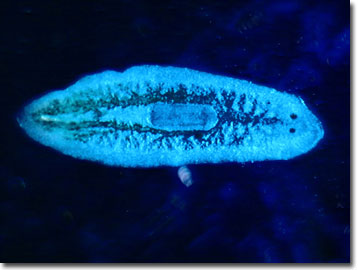Darkfield Digital Image Gallery
Planaria
Planaria are members of the phylum Platyhelminthes (flatworms) in the class Turbellaria. Unlike some of the related parasites in the classes Cestoda (tapeworms) and Trematoda (flukes), planarians are largely free-living, freshwater invertebrates found in or near the sediments of ponds and streams. With triangular heads, flat worm-like bodies, and paired eyespots (ocelli) that give the appearance of being cross-eyed, the bilaterally symmetrical turbellarians are relatively easy to recognize. A piece of liver tied to a string makes a great attractant for planaria when tossed into a pond or slow-moving river.

These flatworms dwell under rocks, submerged leaves, and other debris, and feed on aquatic insects, microcrustaceans, and proteinaceous detritus as scavengers, using a retractable pharynx. Secreted enzymes from the mouth partially digest the prey while it is pinned by the pharynx. Once softened, the mouth sucks in the food and digestion is completed. As negatively phototropic, the eyespots do not actually form images, but detect light, which the crawling or gliding invertebrate actively avoids. Rather than actually swimming, turbellarians propel themselves on hairlike cilia on their ventral surface or by bending using their musculature. Commonly found genera include Dugesia and Stenostomum in quiet waters, and Polycelis ("many eyed") and Phagocata in streams, springs, and other flowing waters.
Although they have primitive brains and central nervous systems, planarians can be taught simple tasks such as traveling through a maze to feed, or to respond to other stimuli. While conducting regeneration experiments, researchers discovered that the flatworms could pass such conditioned responses on to "offspring" created by regeneration. Unlike higher invertebrates, flatworms possess a blind gut instead of an anus. This structure branches throughout their bodies and excretory systems and includes specialized flame cells running the length of the body. In addition to reproducing asexually by regeneration, the hermaphroditic planaria feature an internal reproductive system. When two flatworms join, each exchanges sperm and fertilizes the other's eggs.
Contributing Authors
Cynthia D. Kelly, Thomas J. Fellers and Michael W. Davidson - National High Magnetic Field Laboratory, 1800 East Paul Dirac Dr., The Florida State University, Tallahassee, Florida, 32310.
BACK TO THE DARKFIELD IMAGE GALLERY
BACK TO THE DIGITAL IMAGE GALLERIES
Questions or comments? Send us an email.
© 1995-2025 by Michael W. Davidson and The Florida State University. All Rights Reserved. No images, graphics, software, scripts, or applets may be reproduced or used in any manner without permission from the copyright holders. Use of this website means you agree to all of the Legal Terms and Conditions set forth by the owners.
This website is maintained by our
Graphics & Web Programming Team
in collaboration with Optical Microscopy at the
National High Magnetic Field Laboratory.
Last Modification Friday, Nov 13, 2015 at 01:19 PM
Access Count Since September 17, 2002: 35550
Visit the website of our partner in introductory microscopy education:
|
|
